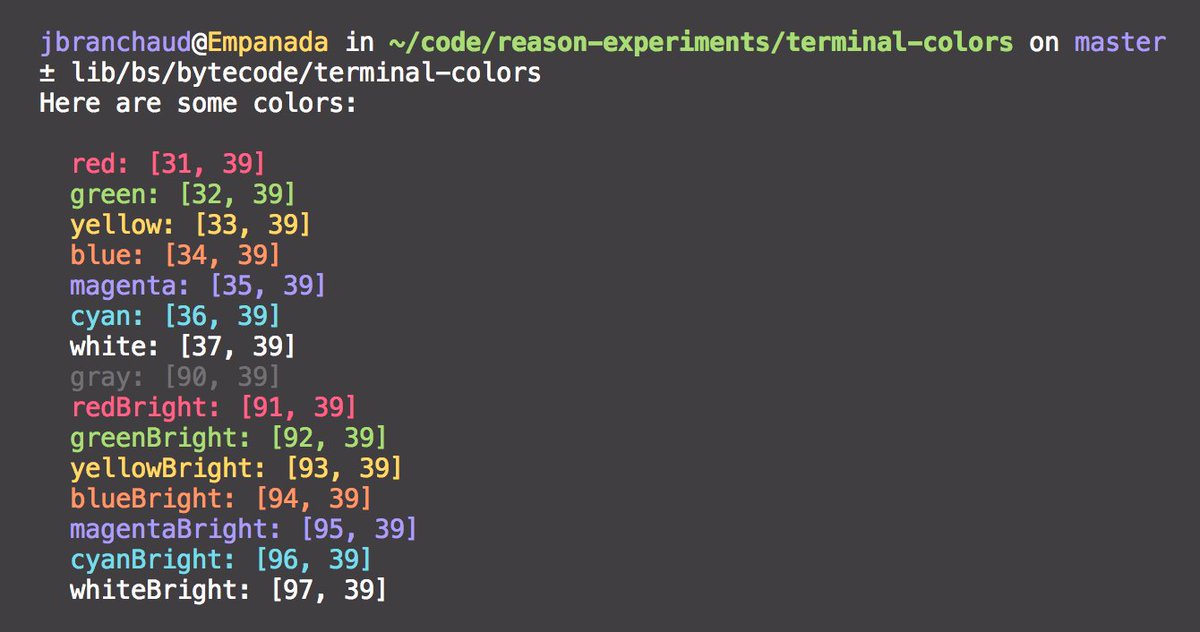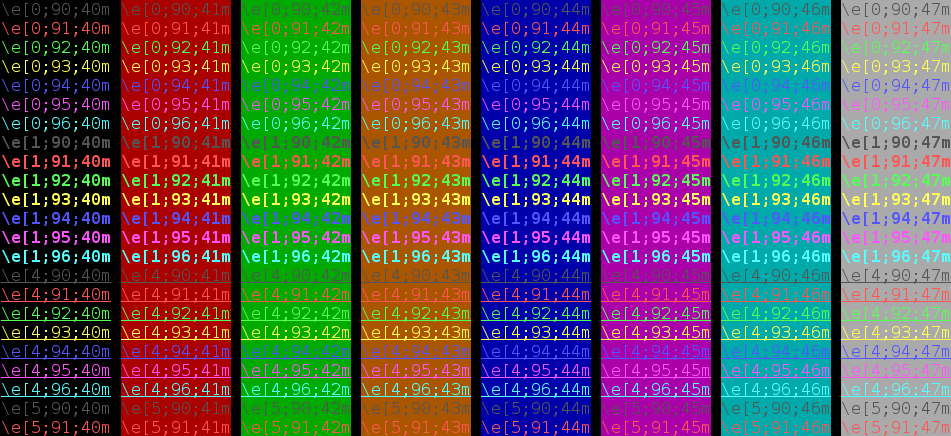

- #Test for ansi escape sequences how to
- #Test for ansi escape sequences manual
- #Test for ansi escape sequences full
# color numbers for tput setaf and tput setab:īlack=0 red=1 green=2 yellow=3 blue=4 magenta=5 cyan=6 white=7Ĭolors='black red green yellow blue magenta cyan white'
#Test for ansi escape sequences how to
here's some bits from terminfo(5), and bit of demonstration program using tput, including colors and some other modes: set_a_foreground setaf AF Set foregroundĮnter_standout_mode smso so begin standout modeĮxit_standout_mode rmso se exit standout modeĮnter_underline_mode smul us begin underline modeĮxit_underline_mode rmul ue exit underline modeĮnter_reverse_mode rev mr turn on reverseĮnter_blink_mode blink mb turn on blinkingĮnter_dim_mode dim mh turn on half-brightĮnter_bold_mode bold md turn on bold (extraĮnter_italics_mode sitm ZH Enter italic modeĮxit_italics_mode ritm ZR End italic modeĮxit_attribute_mode sgr0 me turn off all at-ġ>&2 echo "$0: echo $echo_e '' | read x fails!"ġ>&2 echo "$0: don't know how to do suppress newline with echo" And terminfo even allows one to write a terminal definition relative to another - notably referencing another to use as a base reference, and then adding/removing/changing the defined capabilities relative to that.Īnd. or even want to add a different definition to get somewhat different behavior out of the terminal, one can write the relevant (typically terminfo) entry for such terminal (emulation). So, if you've got a terminal (or emulation) that's not supported, and you want to add it. *nix even has the capability to write descriptions for new/different terminal types. regardless of what terminal type is being used.

got a non-ANSI terminal? Use tput/terminfo/etc., and it'll still work - at least if it can and has the relevant capabilities. But again, don't presume the terminal is ANSI capable. Heck, you can even use tput to figure out ANSI escape codes if you want/need to. Presuming the terminal is ANSII or the like is a bad idea - it may not be at all.Īppropriate approach is to use the relevant terminfo libraries (or alternatively termcap - notably for older systems that may lack terminfo).Īnd as for CLI, that can generally be done using the tput utility. *nix uses and supports hundreds - if not thousands of types of terminal types (and emulations). Well, I see the tag "Linux" on the post, so I would say, in the land of *nix, that's NOT THE WAY TO DO IT! I only have three small features not in ctlseqs, and use XTVERSION and DECRQM to ensure they are only used when the terminal claims support. I do try to stick as close to stock xterm as I can. Rinse and repeat for any additional options.

#Test for ansi escape sequences manual
DECSDM was flat out documented wrong in VT340, which xterm implemented wrong, we all copied, and then j4james found other terminals doing it right, plus the Thai language manual and the VT340 tests so that was a few months of the terminal emulators updating to be correct. someone puts a mostly-transparent image up. hackerb9 recently (and I think saitoha too several years ago) bought a real VT340 and has been testing it with sequences and screenshots so that we can see what should really happen when e.g. ) there is still a lot of wiggle room as to what that means. Thing is even we had terminfo's for "yes, this terminal has sixel" (or iTerm2, or Kitty, or synchronized output, or proper DECSDM. Actually, the same occur with tput via $ printf 'Doing some task.I'm quite far outside robust solutions these days. I searched and read the many questions about, but I did not find anything about this behaviour I experienced. If this should not happen, might this behaviour be triggered indirectly by something in my environment?.Is this the intended desired behaviour? If so, how would I get the done! printed after the task.?.Where the done! is horizontally at the correct position but not vertically (correct in the sense of restored). For example: $ printf 'Doing some task.\e[s\n\nMore text\n\e[udone!\n\n\n' However, it seems that this ANSI sequences restore only the horizontal position of the cursor. Source: Bash Prompt HOWTO: Cursor movement

The movement escape sequences are as follows:
#Test for ansi escape sequences full
This is more useful for full screen user interfaces generated by shell scripts, but can also be used in prompts. Saving and restoring the cursor position should be possible with simple ANSI escape sequencesĪNSI escape sequences allow you to move the cursor around the screen at will.


 0 kommentar(er)
0 kommentar(er)
